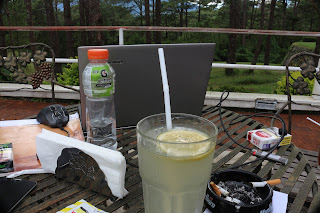Through the city
When we find ourselves growing mold on our skin from lack of exposure to air outside home and university, we go out (where the air is more poisonous, but at least different). Manila, (yes, I am using the term as a mass noun) in general, is overwhelming with sights and sounds and smells - especially smells, that my brain skips entire chunks of it in self defense. There are some very interesting things to see in most places, however, and they dominate my otherwise clunky picture of cities pushed together to sardine conditions.
Certainly there's the teeming industrial architecture all over the place. I was observing to Pasco that we don't have any distinctive style of contemporary architecture, at least if you don't consider narra and coconut wood as materials. He replied, very wisely, or world-wearily, that having no unique architecture is one of the trademarks of being colonized. Being a smartass I hastily added that all our claim to having any sort of Western architecture is embodied by most old provincial churches (like the ones that were unfortunately damaged recently in Bohol due to a bloody cur of an earthquake). The conversation petered out from there, since both of us know jack about architecture anyway.
Almost all the places we go have two states of building (three, if you add "falling apart"): those that are newly built, or those in the process of being newly built. Cranes are hence a fixed.. uh.. fixture in the skyline, which is fine by me, since I have an inexplicable liking for cranes. Whether or not their operators and the hundred other construction workers have sufficient representation to the administration and good working dynamics is another thing altogether.
There are those, however, that are falling apart and yet manage to keep an interesting facade, if only for the equal interest vandals show in them. I find this.. er.. thing.. intriguing, every time we pass by it. I honestly don't know what it was used for, and the top half was gone before I had found out. (Pasco now tells me it was part of a riverboat restaurant). I think it now became a viewdeck type of room for a house near the Marikina river.
There are also those bits of architecture that you know will look good in sepia if you, like a doofus, would want to highlight the contrast between the old and the new. Ah well.
In some places, there are some things arresting, some contrived, some not. The manufactured, contrived ones of course count as art, and the spontaneous ones count as art, though not as artful as the former, which after all get their artsiness from the price tag. However, I can say it is only here, in the big city, that I found metal horses. The provinces are content with real ones.
It is usually around corners, however, that all sorts of surprises, not to mention the execution of childhood toys, lurk. Perhaps as an example to the next person thinking of trespassing. It almost does not matter whether surprising sights like these were done by an adult or a child - what matters is that it was done, for all the world to see.
which makes natural things amid industrial things.. what? Precious? Majestic? Scripted? Laughable? Insufficient? Part of the thing they call "green architecture" before global warming started waving its arms? I'll settle for "different," or "colorful," for now.
After all, there's only so much you can call "natural" without having "industrial" thrown in, and a city is a dynamic mosaic - or an entropic ecosystem, if you prefer - of all these things.
So sometimes I just notice the textures of things, whatever manner of thing they be, knowing that I have to have an organic relation to wherever I am, cosmopolitan or biological makeup be damned. That, after all, is what having a home, or at least a measure of comfortable sanity, requires.

Sometimes we drive. By that I mean Pasco drives, while I the eternal dork take pictures of water droplets on the windshield.
But when we're going somewhere that would otherwise involve the drivers' free-for-all buffet called Edsa, we take the trains instead.
For one, it's faster than the inevitable gridlock and cheaper than the burst aneurysm you would get in Edsa, and for another, it's always interesting to see whether tumbleweeds have already evolved in the Betty Go Belmonte station.
So that's a small illustration of the going through the city, at least from my corner of the universe. Big, inevitable, real. Like an oversized pizza, or Roy Nelson.
And at the end of our day we go home, to grow mold within the week, and then we're at it again.















Comments
Post a Comment